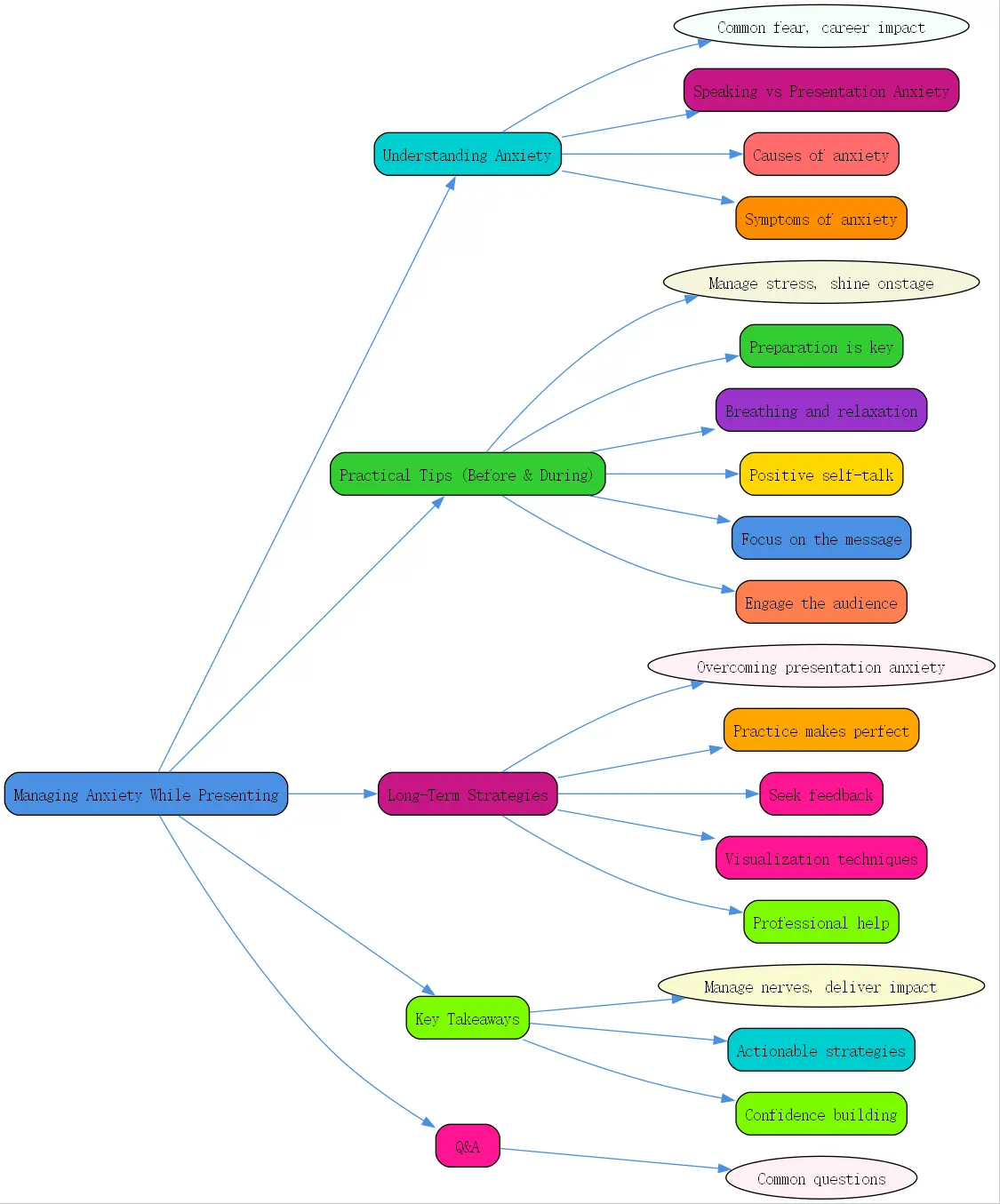Managing Your Anxiety While Presenting: A Comprehensive Guide

Does the thought of speaking in front of an audience make your palms sweat and your heart race? You’re certainly not alone. Public speaking anxiety is incredibly common, affecting people across all professions and experience levels. Like the apprehension some feel before a dental visit, the fear associated with presenting can feel overwhelming, potentially causing you to avoid valuable opportunities. However, just as dental visits are crucial for health, presenting is often vital for career growth and sharing important ideas.

Understanding and tackling this fear head-on is essential. Effective managing your anxiety while presenting doesn’t just make the experience less dreadful; it unlocks your ability to communicate clearly, connect with your audience, and deliver your message with impact. This guide provides actionable strategies, drawing parallels from managing other common anxieties, to help you conquer your nerves and shine on stage.
Understanding Speaking Anxiety and Presentation Anxiety
Glossophobia, or the fear of public speaking, consistently ranks among the most common phobias. This intense fear isn’t just about standing in front of people; it’s a complex reaction often rooted in deeper anxieties. Managing speaking anxiety requires understanding its origins and manifestations.
The prevalence of anxiety related to public speaking: Surveys consistently show that a significant percentage of the population experiences some level of anxiety when speaking in public. It transcends age, gender, and profession. This near-universal experience highlights that feeling nervous is normal, not a sign of weakness or incompetence. Acknowledging its commonality, much like recognizing that dental anxiety is widespread, is the first step toward addressing it without shame.
Common causes and triggers of presentation anxiety: Presentation anxiety can stem from various sources. Fear of judgment or criticism is a major factor – worrying about what others will think of your ideas, delivery, or even your appearance. Past negative experiences, like a poorly received presentation, can create lasting apprehension. Other triggers include fear of forgetting information, fear of technical difficulties, lack of confidence in the material, or simply the unfamiliarity of the situation, similar to how the environment of a dental office can trigger anxiety.
Why managing anxiety is crucial for effective presentations: Uncontrolled anxiety significantly hinders performance. Physical symptoms like a shaky voice, trembling hands, sweating, or blushing can distract both you and your audience. Mentally, anxiety can cause brain fog, making it difficult to recall information or structure thoughts coherently. Effectively managing presentation anxiety allows you to channel that nervous energy constructively, maintain focus, speak clearly, and engage genuinely with your listeners, ultimately making your presentation far more successful.
Practical Tips to Manage Anxiety and Stress Before & During Presentations
Overcoming presentation nerves involves both proactive preparation and in-the-moment coping strategies. Just as preparing for a dental appointment can ease fears, preparing for a presentation builds confidence and reduces uncertainty. Here are practical tips to manage anxiety and stress:
Preparation is Key: Feeling unprepared is a massive trigger for anxiety. Taking control through thorough preparation builds a strong foundation of confidence.
- Thoroughly research your topic: Knowing your subject inside and out is paramount. When you are confident in your knowledge, you’re less likely to be thrown off by unexpected questions or feel like an imposter. Go beyond the surface level; understand the nuances and potential counterarguments. This deep understanding allows for greater flexibility and confidence.
- Practice your presentation multiple times: Rehearsal is non-negotiable. Practice not just what you’ll say, but how you’ll say it. Rehearse out loud, ideally in a setting similar to the actual presentation environment. Record yourself to identify areas for improvement in pacing, tone, and body language. Practice helps solidify the content in your memory, reducing the fear of forgetting.
- Create detailed notes or a script: While you shouldn’t read directly from a script (as it can sound robotic), having detailed notes or key bullet points provides a safety net. Knowing you have structured reminders can alleviate the fear of drawing a blank. Organize your notes clearly so you can glance down and quickly find your place if needed.
Relaxation Techniques: Actively calming your nervous system before you present can make a world of difference. These techniques help manage the physiological symptoms of anxiety.
- Deep breathing exercises for calming nerves: Anxiety often leads to shallow, rapid breathing, which exacerbates physical tension. Practice diaphragmatic (belly) breathing. Inhale slowly through your nose for a count of four, feeling your abdomen expand. Hold briefly. Exhale slowly through your mouth for a count of six. Repeat this cycle several times to slow your heart rate and promote relaxation.
- Meditation and mindfulness practices: Regular meditation or mindfulness exercises can train your brain to stay present and less reactive to anxious thoughts. Even a few minutes of focusing on your breath or bodily sensations before presenting can ground you. Mindfulness helps you acknowledge anxious thoughts without letting them take over, creating mental space.
- Visualization techniques to imagine a successful presentation: Mental rehearsal can be powerful. Close your eyes and vividly imagine yourself delivering the presentation successfully. Picture yourself speaking confidently, the audience engaging positively, and feeling calm and collected. This technique primes your brain for success and can reduce anticipatory anxiety by replacing fearful scenarios with positive ones.
Pre-Presentation Strategies: Actions taken in the hours leading up to your presentation can significantly impact your anxiety levels.
- Avoid caffeine and sugary drinks before presenting: Stimulants like caffeine can mimic or worsen anxiety symptoms like jitters, rapid heartbeat, and restlessness. Sugary drinks can lead to energy crashes. Opt for water or herbal tea instead to stay hydrated without negatively impacting your nervous system or energy levels.
- Get enough sleep the night before: Being well-rested improves focus, emotional regulation, and cognitive function. Lack of sleep can heighten anxiety and make it harder to cope with stress. Prioritize a full night’s sleep to ensure you feel mentally and physically prepared for the challenge ahead. Plan your schedule accordingly.
- Dress comfortably and confidently: Choose an outfit that makes you feel good and aligns with the presentation setting. Discomfort from tight shoes or ill-fitting clothes can be a needless distraction. Feeling confident in your appearance can provide a subtle but significant boost to your overall sense of self-assurance. Plan your outfit in advance.
During the Presentation: How you manage your mindset and actions while speaking is critical.
- Focus on your message, not your anxiety: Shift your attention from your internal feelings of nervousness to the value and purpose of your message. Remember why you are presenting and what you want your audience to take away. Focusing outward on your content and its importance helps diminish self-consciousness and the internal spotlight on anxiety.
- Engage with the audience to reduce self-consciousness: Make eye contact with friendly faces in the audience. Ask questions (if appropriate for the format). Think of the presentation as a conversation rather than a performance. Connection with the audience can make the experience feel less isolating and shift the focus away from your own internal state.
- Use positive self-talk to combat negative thoughts: Anxious minds often default to negative self-criticism. Consciously replace thoughts like “”I’m going to fail”” with positive affirmations like “”I am prepared for this”” or “”I have valuable insights to share.”” Challenge irrational fears with realistic assessments of your capabilities and preparation. This internal pep talk matters.
Long-Term Strategies for Overcoming Presentation Anxiety
While immediate tips are helpful, truly managing presentation anxiety often requires consistent effort over time. Building lasting confidence involves addressing the root causes and gradually expanding your comfort zone. Consider these long-term approaches:
Seeking professional help: Consider therapy or counseling: If presentation anxiety is severe, debilitating, or part of a broader anxiety issue, seeking professional help is highly recommended. Therapists, particularly those specializing in Cognitive Behavioral Therapy (CBT), can provide tools to challenge negative thought patterns and develop coping mechanisms. Much like finding the right dentist who understands patient anxiety, finding a therapist you trust is crucial. They can offer tailored strategies for managing speaking anxiety.

Joining a public speaking group like Toastmasters: Organizations like Toastmasters International provide a supportive, structured environment to practice public speaking regularly. You receive constructive feedback in a low-stakes setting, allowing you to build skills and confidence incrementally. The regular exposure and supportive community can be incredibly effective in desensitizing you to speaking fears over time. It provides a safe space to experiment and grow.
Gradually increasing exposure to speaking situations: Avoidance perpetuates fear. Start small – perhaps by speaking up more in meetings, volunteering for brief announcements, or presenting to small, familiar groups. Gradually increase the duration, audience size, or formality of your speaking engagements as your comfort level grows. This systematic exposure helps retrain your brain’s fear response, demonstrating that you can handle these situations successfully.
Celebrating small victories and progress: Acknowledge and reward yourself for facing your fears, no matter how small the step. Did you speak up in a meeting? Did you practice your presentation without procrastinating? Did you manage your breathing during a nervous moment? Recognizing your progress reinforces positive behavior and motivates you to continue tackling the challenge. Focus on progress, not perfection.
Key Takeaways for Managing Presentation Nerves
- Acknowledge & Normalize: Understand that presentation anxiety is common.
- Prepare Diligently: Research, practice, and organize your notes thoroughly.
- Use Relaxation: Incorporate deep breathing, mindfulness, and visualization.
- Strategize Pre-Presentation: Prioritize sleep, avoid stimulants, and dress for confidence.
- Manage In-the-Moment: Focus on your message, engage the audience, use positive self-talk.
- Seek Long-Term Solutions: Consider professional help, join practice groups, and gradually increase exposure.
- Celebrate Progress: Recognize and reward your efforts along the way.
Q&A: Common Question About Presentation Anxiety
Q: How can SEO principles help someone find resources like this article on managing presentation anxiety?
A: SEO (Search Engine Optimization) plays a crucial role in connecting people seeking help with valuable resources. When someone searches Google for terms like “”managing your anxiety while presenting,”” “”tips to manage anxiety and stress,”” or “”managing speaking anxiety,”” search engines use complex algorithms to find the most relevant and authoritative content.
Websites aiming to provide help, like BrainTalking, optimize their articles by: 1. Keyword Research: Identifying the exact phrases people use when searching (like the core and long-tail keywords mentioned). 2. Content Optimization: Naturally incorporating these keywords into high-quality, comprehensive content (like this article), including titles, headings, and body text. 3. E-E-A-T Signals: Demonstrating Expertise, Experience, Authoritativeness, and Trustworthiness through well-researched content, clear writing, citing sources ([external link: American Psychological Association]), and potentially author bios. 4. User Experience: Ensuring the website is easy to navigate, mobile-friendly, and loads quickly. 5. Internal Linking: Linking to other relevant articles on the site ([internal link: Building Self-Confidence]).
By implementing these SEO practices, resources like this article become more visible in search results, making it easier for individuals struggling with presentation anxiety to find the expert guidance and support they need, precisely when they search for it in 2025 and beyond.





